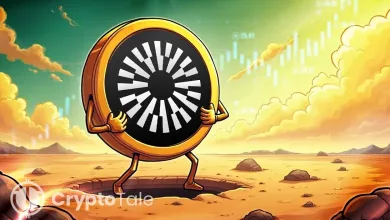Ethereum Whale’s $1.7B Exit from Aave Triggers DeFi Liquidity Squeeze

- Justin Sun was reportedly behind the $1.7B Ethereum withdrawal, which triggered liquidity issues.
- Aave’s borrowing rates spike after massive Ethereum outflows, affecting DeFi strategies.
- The DeFi ecosystem shows vulnerability as whale withdrawals disrupt staking and borrowing.
Marc Zeller, an Aave contributor, believes that crypto billionaire Justin Sun is behind the $1.7 billion worth of Ethereum withdrawn from Aave over the past week. The large withdrawals have created a liquidity shortage, temporarily pushing borrowing rates on the lending protocol to over 10%. This sudden change has triggered a ripple effect throughout the DeFi ecosystem.
According to DefiLlama data, Aave, the biggest lending protocol on Ethereum, stores over $55 billion in deposits. Participants deposit assets such as Ethereum in order to earn interest once these assets are taken up by other parties. The recent huge withdrawals have however reduced its liquidity leaving Aave with much lower liquidity consequently leading to increased borrowing rates.
Justin Sun Behind Massive Ethereum Exodus
As per the sources available, it was found that Justin Sun is the one who caused the direct withdrawals of Ethereum. Sun, the founder of Tron, is known for frequently transferring large amounts of Ethereum across DeFi platforms. On-chain data verifies that wallets connected to Sun were involved, with over $600 million worth of Ethereum withdrawn from Aave in just three days.
Despite the large outflows, Sun’s wallets still hold around $80 million worth of Ethereum on the platform. The situation worsened when HTX, a crypto exchange associated with Sun, withdrew another $455 million from Aave. Sun frequently appears at HTX events, where he discusses its ongoing projects.
In addition to Sun and HTX, London-based Abraxas Capital Management also made significant withdrawals, pulling out a net total of $115 million worth of Ethereum. As the withdrawals piled up, Aave’s available liquidity dwindled, forcing the platform to increase borrowing rates in response.
The increased borrowing rates impacted DeFi strategies reliant on low-interest borrowing. Investors using these strategies saw their positions become unprofitable as borrowing costs surged. Aave’s protocol also limits the amount of Ethereum that can be unstaked at once, resulting in a backlog of 627,944 ETH that will take nearly eleven days to process, according to beaconcha.in.
Liquidity Crunch and stETH Depeg
The liquidity squeeze has also caused problems for DeFi users employing leveraged staking strategies. The Ethereum is deposited, lent out, and when borrowers pay the loans, the user gets additional stETH, only to repeat the process to obtain staking rewards. Nevertheless, this plan became non-viable as borrowing rates accelerated and stETH pegs declined.
Related: Ethereum Boosts Gas Limit, Targets 45M With Validator Support
Consequently, most investors began to roll their positions back. This rate of rush to redeem stETH to Ethereum has created a backlog in the staking withdrawal queues that can now take up to 18 days. Part of the users dumped their stETH on secondary markets, causing a 0.3 percent depeg against the Ethereum price.
To leveraged traders, a 0.3% depeg may be a huge concern. The combination of these two factors could mean huge losses when operating with high leverage and magnify the effects of the slightest changes in prices. The risk of liquidations is on the increase as long as the rates of borrowing keep moving upwards.
As of press time, ETH is trading at $3,625, down by 0.18% over the past day and a slight increase of 0.24% over the past week. Synthetic ETH (sETH) in turn, issued by Synthetix, produced a 30.5% increase, indicating higher demand than interest in alternative assets in a fluctuating market.
The Aave Incident reveals the weak side of the DeFi industry. The withdrawal was so big that it upset the lending rates and caused huge losses to investors. This indicates the danger of the massive and concentrated capital flow in DeFi platforms.




